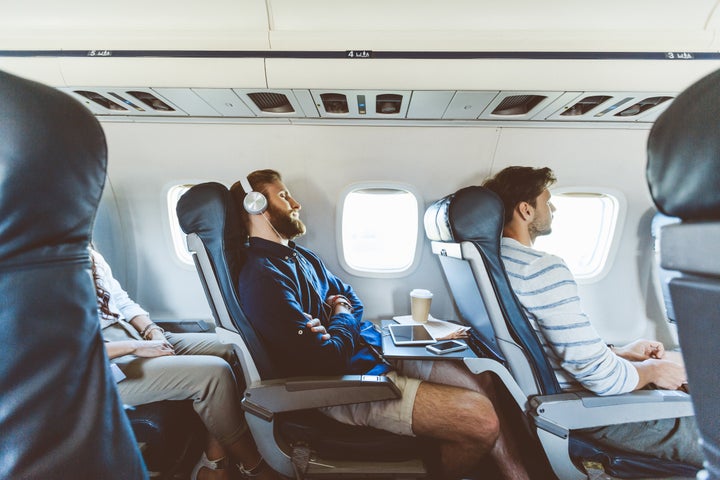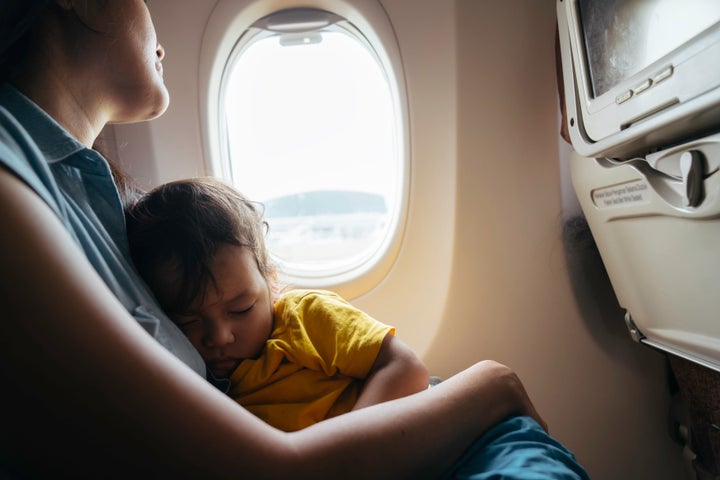
People are rarely at their best during air travel. Just look at the mounting number of in-flight altercations and other troubling incidents these days.
One aspect of flying that really strikes a nerve with many travellers is seat reclining. In November, a video of a screaming match between passengers over one woman’s choice to recline went viral. Three months earlier, there was another viral clip of a passenger who used her arms to keep the seat in front of her in place during a flight from Paris to Los Angeles.
Every time these incidents make headlines, there’s renewed discussion around a divisive travel question: Is it OK to recline or is it just plain rude?
“This is a volatile subject, and there are people on both sides of this debate,” Diane Gottsman, an etiquette expert and corporate trainer specialising in adult behaviour, told HuffPost.
But from an etiquette standpoint, is there an objective right answer to the question of whether or not to recline? Below, Gottsman and other experts break down the best practices.
So, is it OK to recline?
“Whether to recline your seat is a matter of polite awareness,” said Jodi R.R. Smith, the president of Mannersmith Etiquette Consulting. “We want to be able to maximise our comfort without inconveniencing anyone else. This is quite a challenge in the shrinking seats found nowadays on airplanes.”
Some might argue that if they purchased a ticket for an airplane seat that reclines, then they have the right to take advantage of that function. But etiquette coach Tami Claytor believes this mentality highlights an important etiquette rule: “Just because you can do something doesn’t mean you should do it.”
“Etiquette isn’t just about which fork to use ― at its fundamental level it is thinking of others,” Claytor said. “As such, reclining your seat and interfering with someone else’s comfort violates the basic principle of etiquette.”
There are situations in which reclining can be appropriate and more in line with etiquette standards, however. The most important thing is to consider the individual circumstances of your flight, your fellow passenger and yourself.
“For a short flight, it would be most polite to keep your seat up unless you are certain you are not inconveniencing someone behind you,” Gottsman said.
So if the seat behind yours is empty, recline all you want! If there’s a very small child, you can probably recline without encroaching into their space much as well. The same goes for premium cabins.
“For those fortunate enough to be seated in first or business class, this is not an issue,” Smith added. “There is ample room to recline without impacting any other passenger’s personal space.”
Otherwise, try to stay upright during short-haul flights. This makes things much easier for passengers who are very tall or want to use their laptop or drink a beverage on the tray table during the flight.
“If your reclining will negatively impact the person behind you, such as someone with their knee in a brace, you should not recline,” Smith added.
Reclining can also be acceptable for those passengers who are particularly tall, struggle with back problems, or need space to hold their little ones.
“If the passenger is so tall they must fold themselves origami-style into the seat, a few extra inches can make a world of difference, and they may recline after take-off,” Smith said. “If the passenger is juggling a toddler on their lap, they may recline as well. If you do not need the space, such as a 5-year-old in a seat, there is no need to recline.”
The rules are a bit different for long-haul flights, during which reclining is more appropriate.
“If it’s a long flight, it’s unreasonable to expect each passenger not to do what they can to get comfortable,” Gottsman noted. “If it’s a red eye, sleep is important and reclining is acceptable, especially since everyone else is reclining at the same time.”

If you’re going to recline, what’s the right way to do it?
There are best practices for executing your recline if you feel so inclined.
“Look behind you to see if there is someone sitting in the seat directly behind,” Gottsman said. “Check for any issues such as long legs, tray table down, soda on tray, computer on tray, or a baby on their lap. Let the person know you would like to recline. If you are adamant about reclining, and there is no physical reason why you shouldn’t, it’s within reason, but only if it’s not going to physically impede or harm another person.”
Be friendly and either ask if you might recline your seat or just share that you plan to recline your seat.
“If the person behind you isn’t feeling quite so magnanimous and takes umbrage with your request, try negotiating a reasonable compromise such as slightly reclining your seat or only reclining for a specified period of time,” Claytor suggested. “You never know, a polite conversation could lead to a new friendship.”
Take breaks from reclining or move your seat back upright when the crew distributes food and drinks, or the person behind you whips out their laptop.
In order to show consideration and respect for your fellow traveler, also consider easing into the lean and going for a partial recline if possible.
“Start out slow to see how you can feel comfortable without potentially going all the way back,” Gottsman advised.
Another important factor in the reclining conversation is the timing of when you do it.
“It certainly is not proper etiquette to recline your seat as soon as you sit while additional passengers are boarding and settling in their seat,” said Jackie Vernon-Thompson, the founder of From the Inside-Out School of Etiquette. “Reclining your seat during the boarding process, is quite inconsiderate because the back of the seat will obstruct the path and cause the passenger attempting to sit in the seat behind the reclined seat to perhaps have a challenge sitting.”
Unless there are major delays while the plane is parked, your pre-takeoff reclining time will likely be short-lived anyway.
“The Federal Aviation Administration considers takeoff and landing two very critical stages in a flight,” Vernon-Thompson said. “Therefore, they mandate that all seats are placed in an upright position. If reclined at those stages, and there is an emergency, it may prevent passengers from having easy access to the aisle and/or the seat could aggressively slam forward.”
And even if you recline later at a more appropriate time, the flight crew might ask you to move back up.
“Be mindful that at any time during the flight, the pilot and/or flight attendants reserve the right to require all seats in the upright position,” Vernon-Thompson said. “It is of course proper etiquette to adhere to the request. After all, it is in the best interest of all passengers and crew members.”
Remember that there are other ways to make your flight experience easier that go beyond the hot-button issue of reclining.
“Buy a seat with extra leg room, dress comfortably so you can move about in your seat without feeling the need to recline on a short trip,” Gottsman suggested.
The main thing to keep in mind is that you’re in a relatively small communal space, not your own living room recliner. And you and your fellow passengers are all in this together.
“Airplanes these days are tight, so a bit of consideration can go a long way in making everyone more comfortable,” Smith said. “Before I board a plane, with all of the annoyance and indignities, I remind myself that I will be in a chair, in the sky, and how much faster it will be than other modes of transportation. A bit of perspective can shift your attitude toward the positive.”